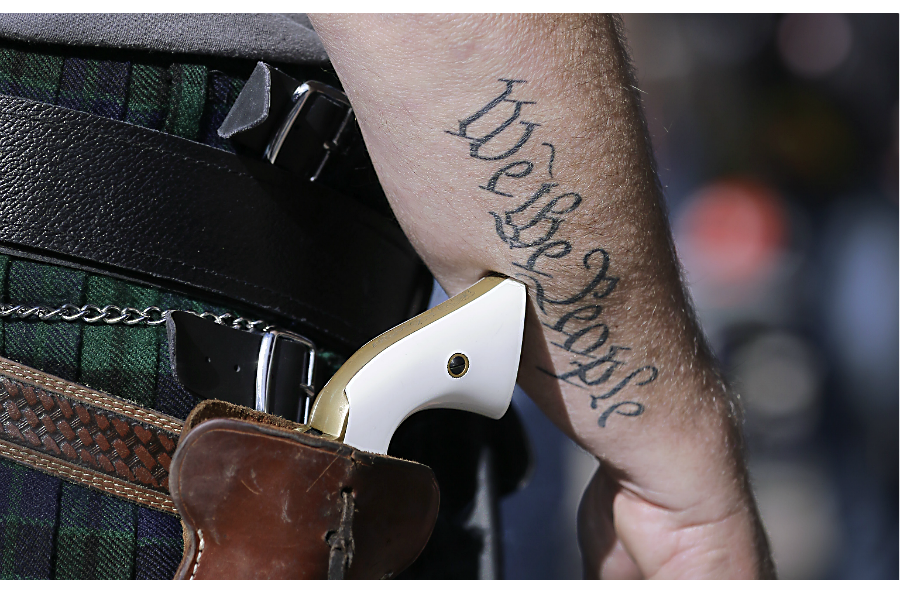Texas gun law: Is the state a model for modern open carry?
Loading...
At least in popular culture, Texas has always been synonymous with gun-totin’ cowboys, but until midnight on New Year's Eve, the reality has been far different. Texas, in fact, has been one of the most restrictive gun-rights states in America.
Thanks to a new law, however, the state will be one of the most relaxed.
How relaxed? Police are discouraged from even asking about someone’s holstered gun. And if they do, they may not have much power to do anything if the person refuses to show a license.
The upshot is that the sight of civilians carrying visible weapons is about to become commonplace in the Lone Star State.
The lawmakers who crafted the legislation passed it in part as a symbolic measure at an unusual time in the United States. Even as gun control groups link America’s obsession with firearms to a slight rise in the number of mass shootings, the US public seems more enamored than ever with weaponry and the power it conveys. Black Friday this year saw the biggest gun cache ever purchased in one day – enough to arm a new military the size of the Marine Corps, as Bob Owens points out on the "Bearing Arms" blog.
Indeed, with notable exceptions in New York, Connecticut, and Colorado, the bulk of states have steadily expanded gun rights since the sunsetting of a 10-year assault weapons ban in 2004. But the new Texas law is Texas-size, given that more than 800,000 Texans are already licensed to carry concealed weapons. Their rights now extend to carrying openly in the halls of the state Capitol.
Given those trends, there’s a fervent debate about whether the new Texas law is a model piece of legislation for a changing America – or a walking disaster just begging for trouble.
To be sure, the law is strict in its own way, offering a model for regulation. Under the law, open-carry folks have to be licensed, a process that includes safety and shooting tests. They also have to show no prior psychological problems, and they have to be at least 21 years old.
But a major sticking point is how the law will affect policing in one of the nation’s most populous expanses. The fact that the law doesn’t provide any sanctions against those who refuse to show a license to a police officer has critics fearing that officers may be handcuffed in their ability to respond to volatile and potentially deadly situations.
The issue of open carry has also been drawn into the debate over aggressive policing in minority communities. Recently, a white man armed with an assault-style rifle walked legally through Akron, Ohio – the same state where two Cleveland police officers in 2014 fatally shot Tamir Rice, a 12-year-old black boy who was playing with a pellet gun.
The real crux of the debate over the Texas law, however, is the extent to which it may inspire irresponsible wielding of weapons in public. After all, armed citizens will no longer be deemed suspicious, even though a lot of people might be alarmed by the sight. Most police in Texas have been told to not engage gun carriers unless they are doing something questionable or appear intoxicated.
“What a lot of police are worried about is not that there’s going to be open carry, but that there’s going to be a deliberate effort to exercise that right in what I might characterize as an ‘unusually zealous’ way,” Geoffrey Corn, a professor at the South Texas College of Law, told the Fusion website. “And there can be a lot of chaos in those circumstances.”
The law stands in stark contrast to other big states. California and New York both don’t allow open carry. It’s also against the law in the conservative hotbed of South Carolina. It’s far from clear whether more large states will adopt the Texas model.
But one national backdrop to the Texas law is growing skepticism about the ability of more restrictive gun laws to stem violence. That's despite the experiences of countries such as Great Britain and Australia, where gun violence dropped dramatically after restrictive laws were put in place.
According to a recent Gallup poll, 56 percent of Americans believe that concealed-carry laws, for instance, make them safer – a contrast with a similar poll a decade earlier where two thirds of respondents said they’d feel less safe in a place where concealed weapons were allowed.
At the same time, however, 4 out of 5 Americans do support improving the background check process to increase assuredness that Americans who decide to arm themselves are of sound mind and character.
For sure, New Year's Day will be an exciting one for Texas gun owners. What's not yet known is how the rest of Texas will respond.
For now, police departments have been getting ready by training officers and dispatchers on the legal changes around open carry. With large 911 call volumes anticipated about armed citizens in the streets, dispatchers have been trained to say: “It’s now legal to do that.”






